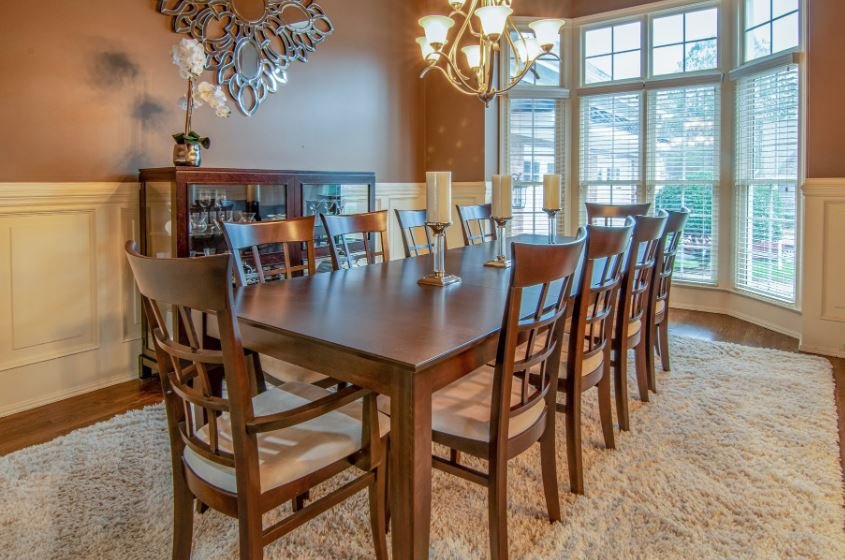The dining room, once a staple of every home, is gradually vanishing from modern living spaces. Changing lifestyles, the rise of open-plan homes, and evolving social habits have contributed to the disappearance of dedicated dining areas. As more families opt for multifunctional spaces, the traditional dining room has become less necessary, raising the question: are dining rooms becoming obsolete?
In this article, we’ll explore the reasons behind the disappearing dining rooms, their significance in modern home design, and what this shift means for homeowners and interior designers. We’ll also discuss the benefits, challenges, and potential solutions to creating functional dining spaces in today’s homes.

The Evolution of Dining Spaces
Traditional Dining Rooms: A Historical Perspective
Dining rooms were once considered an essential feature in most homes. Traditionally, these spaces were dedicated to formal meals, especially in the 18th and 19th centuries. Families would gather here to share meals, entertain guests, and celebrate special occasions.
The Rise of Open-Plan Living
In recent decades, the trend toward open-plan living has drastically reshaped how we use our spaces. With kitchens, living rooms, and dining areas merging into one, the need for a separate dining room has diminished. Open-plan spaces are versatile, allowing families to cook, eat, and socialize in a single area.
The Impact of Modern Lifestyles
Busier lifestyles and a shift toward more casual eating habits have also contributed to the disappearance of dining rooms. Many families now eat on the go or have informal meals in front of the television, reducing the need for a dedicated dining space.
Why Are Dining Rooms Disappearing?
Changing Family Dynamics
As family structures evolve, so do the spaces they occupy. The nuclear family is no longer the norm, and smaller, more flexible living arrangements have become popular. Homes with fewer people don’t always require large dining rooms, leading to the decline of these spaces.
Space Optimization in Smaller Homes
With rising real estate prices, homes are shrinking in size. Every square foot counts, and homeowners prioritize multifunctional spaces that can serve various purposes. Dining rooms often take up valuable space that could be used more efficiently for a home office, play area, or extra storage.
Casual Dining and Entertaining Trends
The way we entertain has also changed. Casual get-togethers, buffets, and kitchen islands are now common in modern homes. Instead of hosting formal dinners, people prefer flexible spaces where guests can mingle freely. This shift in dining habits has led to the gradual decline of formal dining rooms.
Benefits of Open-Plan Spaces Over Traditional Dining Rooms
Increased Functionality and Flexibility
One of the main reasons for the disappearing dining rooms is the increased functionality of open-plan layouts. These spaces allow homeowners to adapt the area to suit their needs, whether it’s for dining, working, or lounging. The flexibility of these spaces makes them ideal for modern living.
Enhanced Social Interaction
Open-plan spaces promote social interaction by eliminating barriers between the kitchen, living room, and dining area. Family members and guests can easily communicate and interact, making these spaces more engaging and lively compared to isolated dining rooms.
Better Use of Natural Light
With fewer walls separating different areas of the home, open-plan designs allow more natural light to flow through the space. This not only makes the home feel brighter and more spacious but also creates a welcoming and comfortable environment.
Challenges of the Disappearing Dining Room
Lack of Defined Dining Space
While open-plan layouts offer flexibility, they can sometimes lead to the absence of a clearly defined dining space. Without a designated area for eating, mealtime can become less structured, and the dining experience may lose its formality.
Noise and Distractions
Open spaces can also be noisier and more distracting, especially when multiple activities are happening simultaneously. The lack of separation between the kitchen and living areas can make it harder to enjoy a quiet meal, particularly in busy households.
Maintaining a Sense of Tradition
For some, the disappearance of the dining room represents a loss of tradition. Formal dining rooms have long been associated with family gatherings, celebrations, and special occasions. The absence of this space may diminish the importance of these events in the home.
Creative Solutions for the Modern Dining Space
Multifunctional Dining Areas
One solution to the disappearing dining room is to create multifunctional dining areas within open-plan spaces. A well-placed dining table can serve as both a place for meals and a workspace. Designers can incorporate furniture that blends seamlessly with the rest of the home, ensuring that the dining area remains functional yet unobtrusive.
Defining Spaces with Furniture and Decor
To maintain the feeling of a dedicated dining space within an open-plan layout, homeowners can use furniture and decor to define specific areas. A statement chandelier, a stylish rug, or a feature wall can create visual separation between the dining and living spaces without the need for walls.
The Return of the Dining Nook
For those who still want a dedicated dining space but lack the room for a full dining room, a dining nook can be a great compromise. These cozy, built-in areas provide a defined space for meals without taking up too much square footage. They are particularly popular in smaller homes or apartments where space is at a premium.
The Future of Dining Rooms
The Hybrid Dining Room
As homes continue to evolve, the concept of a hybrid dining room may become more popular. This space would serve multiple functions, acting as both a dining area and a space for business,working, studying, or socializing. By designing flexible spaces that can adapt to different needs, homeowners can retain the functionality of a dining room without sacrificing valuable space.
Dining Rooms as Luxury Spaces
In larger homes, dining rooms may not disappear entirely but instead become luxury spaces reserved for special occasions. These rooms could be used for hosting formal dinners, holiday celebrations, or other events, while everyday meals take place in a more casual setting.
Integration with Outdoor Spaces
Another trend that may emerge is the integration of dining spaces with outdoor areas. As indoor-outdoor living becomes more popular, dining rooms could open up to patios or gardens, allowing for alfresco dining in warmer months. This seamless connection between indoor and outdoor spaces offers a fresh take on the traditional dining room.
Case Studies: Homes Without Dining Rooms
Small Urban Apartments
In many urban areas, space is limited, and dining rooms are often the first to go. In small apartments, open-plan kitchens with islands or breakfast bars serve as dining areas. These spaces are designed to be multifunctional, making the most of the limited square footage.
Modern Family Homes
In newer family homes, the dining room is often replaced by a large, open kitchen and living space. These homes feature flexible layouts where families can eat, work, and relax in the same area. The dining table may be positioned near the kitchen island or in a corner of the living space, blending seamlessly with the rest of the home.
Luxury Homes with Formal Dining Rooms
While dining rooms are disappearing in smaller homes, luxury properties often still include formal dining spaces. These rooms are used for entertaining guests and hosting formal events. However, even in these homes, the dining room is often secondary to the more casual, open-plan kitchen and living areas.
Overcoming Challenges: Tips for Designing Modern Dining Spaces
Choose Flexible Furniture
Opt for furniture that can serve multiple purposes. A dining table that doubles as a desk or a set of foldable chairs can help save space while keeping the dining area functional.
Use Lighting to Define the Space
Lighting plays a crucial role in defining a dining area within an open-plan layout. A statement pendant light or chandelier can create a focal point above the dining table, visually separating it from the rest of the space.
Keep the Design Cohesive
When designing a dining area in an open space, it’s important to keep the design cohesive with the rest of the room. Choose furniture, colors, and decor that complement the overall style of the home to create a harmonious and visually appealing space.
Conclusion
The concept of the traditional dining room is rapidly changing as modern lifestyles evolve. While dedicated dining rooms may be disappearing from many homes, the need for functional and flexible dining spaces remains. By embracing open-plan designs, multifunctional furniture, and creative solutions, homeowners can still enjoy the benefits of a dining area without sacrificing space or style. The future of dining rooms lies in adaptability, with spaces that can serve multiple purposes while maintaining a sense of comfort and style.
FAQs
1. Why are dining rooms disappearing from modern homes?
Dining rooms are disappearing due to changing lifestyles, open-plan designs, and a shift towards casual dining and multifunctional spaces.
2. How can I create a dining space in an open-plan home?
You can create a dining space by using furniture, lighting, and decor to visually separate the dining area from the rest of the room.
3. Are formal dining rooms still relevant today?
Formal dining rooms are becoming less common, but they are still relevant in larger homes or for those who frequently host formal gatherings.
4. What are some alternatives to a traditional dining room?
Alternatives include dining nooks, kitchen islands with seating, and multifunctional spaces that combine dining with other activities.
5. How can I make my dining area feel more defined in an open space?
Use lighting, rugs, and furniture placement to define the dining area and create a sense of separation from the surrounding space.


